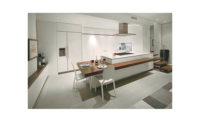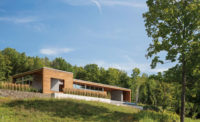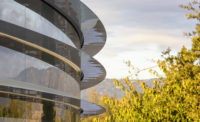Southampton, NY
For the expansion of a 1970s-era kit house on the East End of Long Island in Southampton, New York, architect Paul Masi looked to the structure’s muscular prefabricated components for design cues—a choice that ultimately informed the look and feel of the addition’s bold new kitchen, completed last year.
“We liked the idea of an expressed structure—you see it, you read it, you understand how the building stands up,” says Masi, a principal of Bates Masi + Architects, based in nearby Sag Harbor.
The Far Pond residence, a two-story house with weathered wood cladding and ample glazing, rests on a half-acre site overlooking wetlands. The client, a New York–based events planner with a keen eye and a pet Yorkie, needed a generous kitchen to accommodate weekend guests and dinner parties.
Although Masi eschewed mimicking the post-and-beam structure of the original house, he was especially drawn to the raw quality of the exposed black steel connectors between the existing glue-laminated beams and the columns. He also wanted a system that would serve as both structure and finish material. “As architects, we like materials that can perform multiple roles.”
The designers conducted extensive research, exploring the ways in which metal akin to that of the connectors could be incorporated into the addition. They discovered shear wall panels that derive their strength from sheet metal bent over and over on itself. Such rigid elements, normally hidden, are typically used for light-frame construction in hurricane-prone areas. But at the Far Pond house, the 2-foot-wide panels, which are made from light-gauge steel, are exposed and perform as both structure and the backdrop for the upper-level kitchen.
To avoid concealing these panels behind kitchen appliances, the architects opted to pull the program away from the wall: the majority of the kitchen activities center around a monolithic island, 10 feet long and 5 feet 6 inches wide, which contains a sink and provides extra seating. To contrast with and enhance the minimal black steel panels and the oak floor and ceiling, Masi used a white solid surface material for the island, cabinet faces, and kitchen-area flooring.
The kitchen's crown jewel is its gravity-defying 10-foot-long counter with a cooktop, which cantilevers from the metal wall. Notched vertical fins—folds that protrude from the panelized steel structural system—do double duty by helping to support the stovetop slab and a shelf above, and by providing visual rhythm. A perforated-metal screen cleverly conceals downdraft vents and can slide out of the indentations for easy cleaning. This style of screen also appears on the stair, windows, and forms a custom light fixture.
Just off of the kitchen is a daylight-filled dining room. It is surrounded by sliding glass doors on two sides that provide access to a series of decks and a layered view of a backyard pond, a bay, and the Atlantic Ocean beyond.
Size: 500 square feet
Project Cost: withheld
Completion Date: September 2013
People
Architect:
General Contractor: |
Products
Custom Cabinetry:
Countertops:
Appliances:
Plumbing Fixtures:
Paints/Stains:
Windows:
Lighting: |








Post a comment to this article
Report Abusive Comment